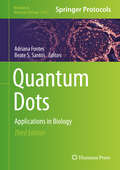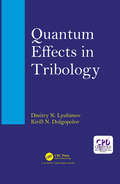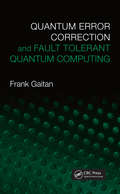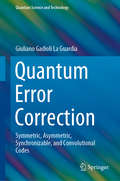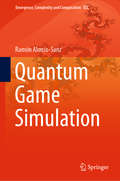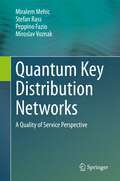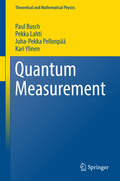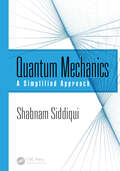- Table View
- List View
Quantum Dots: Applications in Biology (Methods in Molecular Biology #2135)
by Adriana Fontes Beate S. SantosThis third edition provides revised and expanded protocols of consolidated approaches as well as new trends in the field. Chapters guide readers through new approaches to optimize Quantum Dots’ (QD) properties, to evaluate their quantum yields, important features about preparative processes and characterizations of QDs, methods related to QDs for live cell applications, and the versatility of QDs in the bioanalytical and biosensing field. Written in the highly successful Methods in Molecular Biology series format, chapters include introductions to their respective topics, lists of the necessary materials and reagents, step-by-step, readily reproducible laboratory protocols, and tips on troubleshooting and avoiding known pitfalls.
Quantum Dynamics and Laser Control for Photochemistry
by Matthieu SalaThe central subject of this thesis is the theoretical description of ultrafast dynamical processes in molecular systems of chemical interest and their control by laser pulses. This work encompasses different cutting-edge methods in quantum chemistry, quantum dynamics and for the rigorous description of the interaction of light and matter at the molecular level. It provides a general quantum mechanical framework for the description of chemical processes guided by laser pulses, in particular near conical intersections, i. e. geometries where the nuclear and electronic motions couple and the molecule undergoes non-adiabatic (or non-Born-Oppenheimer) dynamics. In close collaboration with experimentalists, the author succeeds in making a decisive step to link and to apply quantum physics to chemistry by transferring state of the art techniques and concepts developed in physics to chemistry, such as "light dressed atoms and molecules" and "adiabatic Floquet theory". He applies these techniques in three prototypic model systems (aniline, pyrazine and NHD2) using high-level electronic structure calculations. Readers will enjoy the comprehensive and accessible introduction to the topic and methodology, as well as the clear structure of the thesis.
Quantum Effects in Tribology
by Dmitry Nikolaevich Lyubimov Kirill Nikolaevich DolgopolovQuantum Effects in Tribology is devoted to the study of quantum foundations of materials friction interaction and evolutionary formation of tribosystem’s operating parameters. At the start of the book, large consideration is given to the analysis of the existing diversity of friction, wear, and lubrication models and their relationship with each other, as well as to the quantum nature of the measurement process and the wave function reduction caused by the act of measurement. Consideration of measurement as a process of defining the output parameters of tribosystem is carried out with the apparatus of second quantization and conceptions associated with non-local quantum effects. Such an approach makes it possible not only to take another look to the evolution of tribosystems but discover previously unknown regularities of friction. The book is intended for professionals working in the field of tribology, but will be also useful for graduate students specializing in the theory of friction and quantum physics.
Quantum Error Correction and Fault Tolerant Quantum Computing
by Frank GaitanIt was once widely believed that quantum computation would never become a reality. However, the discovery of quantum error correction and the proof of the accuracy threshold theorem nearly ten years ago gave rise to extensive development and research aimed at creating a working, scalable quantum computer. Over a decade has passed since this monumental accomplishment yet no book-length pedagogical presentation of this important theory exists.Quantum Error Correction and Fault Tolerant Quantum Computing offers the first full-length exposition on the realization of a theory once thought impossible. It provides in-depth coverage on the most important class of codes discovered to date—quantum stabilizer codes. It brings together the central themes of quantum error correction and fault-tolerant procedures to prove the accuracy threshold theorem for a particular noise error model. The author also includes a derivation of well-known bounds on the parameters of quantum error correcting code. Packed with over 40 real-world problems, 35 field exercises, and 17 worked-out examples, this book is the essential resource for any researcher interested in entering the quantum field as well as for those who want to understand how the unexpected realization of quantum computing is possible.
Quantum Error Correction: Symmetric, Asymmetric, Synchronizable, and Convolutional Codes (Quantum Science and Technology)
by Giuliano Gadioli La GuardiaThis text presents an algebraic approach to the construction of several important families of quantum codes derived from classical codes by applying the well-known Calderbank-Shor-Steane (CSS), Hermitian, and Steane enlargement constructions to certain classes of classical codes. In addition, the book presents families of asymmetric quantum codes with good parameters and provides a detailed description of the procedures adopted to construct families of asymmetric quantum convolutional codes.Featuring accessible language and clear explanations, the book is suitable for use in advanced undergraduate and graduate courses as well as for self-guided study and reference. It provides an expert introduction to algebraic techniques of code construction and, because all of the constructions are performed algebraically, it enables the reader to construct families of codes, rather than only codes with specific parameters. The text offers an abundance of worked examples, exercises, and open-ended problems to motivate the reader to further investigate this rich area of inquiry. End-of-chapter summaries and a glossary of key terms allow for easy review and reference.
Quantum Finance: Intelligent Forecast and Trading Systems
by Raymond S. LeeWith the exponential growth of program trading in the global financial industry, quantum finance and its underlying technologies have become one of the hottest topics in the fintech community. Numerous financial institutions and fund houses around the world require computer professionals with a basic understanding of quantum finance to develop intelligent financial systems. This book presents a selection of the author’s past 15 years’ R&D work and practical implementation of the Quantum Finance Forecast System – which integrates quantum field theory and related AI technologies to design and develop intelligent global financial forecast and quantum trading systems. The book consists of two parts: Part I discusses the basic concepts and theories of quantum finance and related AI technologies, including quantum field theory, quantum price fields, quantum price level modelling and quantum entanglement to predict major financial events. Part II then examines the current, ongoing R&D projects on the application of quantum finance technologies in intelligent real-time financial prediction and quantum trading systems. This book is both a textbook for undergraduate & masters level quantum finance, AI and fintech courses and a valuable resource for researchers and data scientists working in the field of quantum finance and intelligent financial systems. It is also of interest to professional traders/ quants & independent investors who would like to grasp the basic concepts and theory of quantum finance, and more importantly how to adopt this fascinating technology to implement intelligent financial forecast and quantum trading systems. For system implementation, the interactive quantum finance programming labs listed on the Quantum Finance Forecast Centre official site (QFFC.org) enable readers to learn how to use quantum finance technologies presented in the book.
Quantum Game Simulation (Emergence, Complexity and Computation #36)
by Ramon Alonso-SanzThis book addresses two disciplines that have traditionally occupied completely different realms: quantum information and computation, and game theory. Helping readers connect these fields, it appeals to a wide audience, including computer scientists, engineers, mathematicians, physicists, biologists or economists. The book is richly illustrated and basic concepts are accessible to readers with basic training in science. As such it is useful for undergraduate students as well as established academicians and researchers. Further, the didactic and tutorial-like style makes it ideal supplementary reading for courses on quantum information and computation, game theory, cellular automata and simulation.
Quantum Hybrid Electronics and Materials (Quantum Science and Technology)
by Hiroshi Yamaguchi Yoshiro Hirayama Kazuhiko HirakawaThis book highlights recent advances in quantum control technologies with regard to hybrid quantum systems. It addresses the following topics: phonon engineering based on phononic crystals, carbon-based nano materials like graphene and nanotubes, Terahertz light technology for single-molecule and quantum dots, nuclear-spin-based metrology for semiconductor quantum systems, quantum anomalous Hall effect in magnetic topological insulators, chiral three-dimensional photonic crystals, and bio-inspired magnonic systems. Each topic, as a component in the framework of hybrid quantum systems, is concisely presented by experts at the forefront of the field. Accordingly, the book offers a valuable asset, and will help readers find advanced technologies and materials suitable for their purposes.
Quantum Image Processing in Practice: A Mathematical Toolbox
by Artyom M. Grigoryan Sos S. AgaianComprehensive resource addressing the need for a quantum image processing machine learning model that can outperform classical neural networks Quantum Image Processing in Practice explores the transformative potential of quantum color image processing across various domains, including biomedicine, entertainment, economics, and industry. The rapid growth of image data, especially in facial recognition and autonomous vehicles, demands more efficient processing techniques. Quantum computing promises to accelerate digital image processing (DIP) to meet this demand. This book covers the role of quantum image processing (QIP) in quantum information processing, including mathematical foundations, quantum operations, image processing using quantum filters, quantum image representation, and quantum neural networks. It aims to inspire practical applications and foster innovation in this promising field. Topics include: Qubits and Quantum Logic Gates: Introduces qubits, the fundamental data unit in quantum computing, and their manipulation using quantum logic gates like Pauli matrices, rotations, the CNOT gate, and Hadamard matrices. The concept of entanglement, where qubits become interconnected, is also explored, highlighting its importance for applications like quantum teleportation and cryptography. Two and Multiple Qubit Systems: Demonstrates the importance of using two qubits to process color images, enabling image enhancement, noise reduction, edge detection, and feature extraction. Covers the tensor product, Kronecker sum, SWAP gate, and local and controlled gates. Extends to multi-qubit superpositions, exploring local and control gates for three qubits, such as the Toffoli and Fredkin gates, and describes the measurement of superpositions using projection operators. Transforms and Quantum Image Representations: Covers the Hadamard, Fourier, and Heap transforms and their circuits in quantum computation, highlighting their applications in signal and image processing. Introduces the quantum signal-induced heap transform for image enhancement, classification, compression, and filtration. Explores quantum representations and operations for images using the RGB, XYZ, CMY, HSI, and HSV color models, providing numerous examples. Fourier Transform Qubit Representation: Introduces a new model of quantum image representation, the Fourier transform qubit representation. Describes the algorithm and circuit for calculating the 2-D quantum Fourier transform, enabling advancements in quantum imaging techniques. New Operations and Hypercomplex Algebra: Presents new operations on qubits and quantum representations, including multiplication, division, and inverse operations. Explores hypercomplex algebra, specifically quaternion algebra, for its potential in color image processing. Quantum Neural Networks (QNNs): Discusses QNNs and their circuit implementation as advancements in machine learning driven by quantum mechanics. Summarizes various applications of QNNs and current trends and future developments in this rapidly evolving field. The book also addresses challenges and opportunities in QIP research, aiming to inspire practical applications and innovation. It is a valuable resource for researchers, students, and professionals interested in the intersection of quantum computing and color image processing applications, as well as those in visual communications, multimedia systems, computer vision, entertainment, and biomedical applications.
Quantum Information in the Nanoelectronic World (Synthesis Lectures on Engineering, Science, and Technology)
by David K. FerryThis book provides a concise introduction to quantum information and quantum science. The author discusses in language accessible to a broad audience, the why and how, as well as implementation technologies. The discussion includes coverage of general computing (e.g., Turing ideas) for comparison, and ideas like entropy and minimum dissipation. Topics such as quantum communications and quantum sensing enhance the discussion of quantum computing. In addition, the manner in which entanglement is used in each of these sub-fields is addressed with applications and, for example, a discussion of the quantum Fourier transform.
Quantum Inspired Meta-heuristics for Image Analysis
by Ujjwal Maulik Siddhartha Bhattacharyya Sandip DeyIntroduces quantum inspired techniques for image analysis for pure and true gray scale/color images in a single/multi-objective environment This book will entice readers to design efficient meta-heuristics for image analysis in the quantum domain. It introduces them to the essence of quantum computing paradigm, its features, and properties, and elaborates on the fundamentals of different meta-heuristics and their application to image analysis. As a result, it will pave the way for designing and developing quantum computing inspired meta-heuristics to be applied to image analysis. Quantum Inspired Meta-heuristics for Image Analysis begins with a brief summary on image segmentation, quantum computing, and optimization. It also highlights a few relevant applications of the quantum based computing algorithms, meta-heuristics approach, and several thresholding algorithms in vogue. Next, it discusses a review of image analysis before moving on to an overview of six popular meta-heuristics and their algorithms and pseudo-codes. Subsequent chapters look at quantum inspired meta-heuristics for bi-level and gray scale multi-level image thresholding; quantum behaved meta-heuristics for true color multi-level image thresholding; and quantum inspired multi-objective algorithms for gray scale multi-level image thresholding. Each chapter concludes with a summary and sample questions. Provides in-depth analysis of quantum mechanical principles Offers comprehensive review of image analysis Analyzes different state-of-the-art image thresholding approaches Detailed current, popular standard meta-heuristics in use today Guides readers step by step in the build-up of quantum inspired meta-heuristics Includes a plethora of real life case studies and applications Features statistical test analysis of the performances of the quantum inspired meta-heuristics vis-à-vis their conventional counterparts Quantum Inspired Meta-heuristics for Image Analysis is an excellent source of information for anyone working with or learning quantum inspired meta-heuristics for image analysis.
Quantum Key Distribution Networks: A Quality of Service Perspective
by Stefan Rass Miralem Mehic Peppino Fazio Miroslav VoznakThis book focuses on practical implementation details, telecommunication techniques, security and technology challenges and approaches to implementing quantum technology in modern telecommunication systems. The authors use their extensive practical academic and industrial experience in network technologies and provide details from international projects in quantum cryptography in which they actively participate. Using a variety of examples, analogies, illustrations, tables, and features from practical quantum network realizations, the authors provide a unique view of quantum technology from an engineering telecommunication standpoint, allowing the reader to identify the advantages and challenges of quantum technology.This book also addresses challenges posed by quantum technology such as network organization, passive and active eavesdropping, and future trends in QKD such as Software Defined Networking (SDN) with QKD and application QKD in 5G networks. It is conceived through eight chapters by treating the following thematic units separately: Fundamentals of Quantum Key Distribution, QoS architecture/mode, QoS MAC layer, QoS signaling techniques for key management and session negotiation purpose and QoS routing protocols that minimize the consumption of key material through the equitable utilization of network resources when finding an optimal path. Through numerous information on practical solutions, simulation examples, illustrations, and analysis, readers can easily distinguish the specificity of quantum technology and understand the challenges and methods of practical implementation of quantum cryptography in common telecommunications standards. Researchers working in quantum technology and applied networking security as well as advanced-level students studying computer science and electrical engineering will benefit from this book. Professionals working within these related fields will also benefit from this book.
Quantum Level Business Model: A New Managerial Perspective (Big and Integrated Artificial Intelligence #3)
by Pantea Foroudi Maria Teresa CuomoEmbracing complexity as an opportunity, this groundbreaking book introduces Quantum Level Management—an agile, probabilistic, and interconnected approach to business. By applying principles from Quantum Science, it offers a radically new framework for strategic planning, decision-making, and organizational design. A key contribution is its ambidextrous logic: the ability to balance structure with flexibility, control with creativity, and stability with innovation. A dedicated section explores real-world applications in financial markets, a critical arena for testing and advancing Quantum Technologies. With critical insights, practical tools, and compelling case studies, this book empowers students, scholars, executives, and entrepreneurs to navigate an uncertain and dynamic quantum environment.
Quantum Man: Richard Feynman's Life In Science (Great Discoveries #0)
by Lawrence M. Krauss"A worthy addition to the Feynman shelf and a welcome follow-up to the standard-bearer, James Gleick's Genius." --Kirkus Reviews Perhaps the greatest physicist of the second half of the twentieth century, Richard Feynman changed the way we think about quantum mechanics, the most perplexing of all physical theories. Here Lawrence M. Krauss, himself a theoretical physicist and a best-selling author, offers a unique scientific biography: a rollicking narrative coupled with clear and novel expositions of science at the limits. From the death of Feynman's childhood sweetheart during the Manhattan Project to his reluctant rise as a scientific icon, we see Feynman's life through his science, providing a new understanding of the legacy of a man who has fascinated millions.
Quantum Many Body Systems
by Vieri Mastropietro Jakob Yngvason Vincent Rivasseau Jan Philip Solovej Thomas Spencer Alessandro Giuliani Robert SeiringerThe book is based on the lectures given at the CIME school "Quantum many body systems" held in the summer of 2010. It provides a tutorial introduction to recent advances in the mathematics of interacting systems, written by four leading experts in the field: V. Rivasseau illustrates the applications of constructive Quantum Field Theory to 2D interacting electrons and their relation to quantum gravity; R. Seiringer describes a proof of Bose-Einstein condensation in the Gross-Pitaevski limit and explains the effects of rotating traps and the emergence of lattices of quantized vortices; J.-P. Solovej gives an introduction to the theory of quantum Coulomb systems and to the functional analytic methods used to prove their thermodynamic stability; finally, T. Spencer explains the supersymmetric approach to Anderson localization and its relation to the theory of random matrices. All the lectures are characterized by their mathematical rigor combined with physical insights.
Quantum Many-Body Physics in Open Systems: Measurement and Strong Correlations (Springer Theses)
by Yuto AshidaThis book studies the fundamental aspects of many-body physics in quantum systems open to an external world. Recent remarkable developments in the observation and manipulation of quantum matter at the single-quantum level point to a new research area of open many-body systems, where interactions with an external observer and the environment play a major role. The first part of the book elucidates the influence of measurement backaction from an external observer, revealing new types of quantum critical phenomena and out-of-equilibrium dynamics beyond the conventional paradigm of closed systems. In turn, the second part develops a powerful theoretical approach to study the in- and out-of-equilibrium physics of an open quantum system strongly correlated with an external environment, where the entanglement between the system and the environment plays an essential role. The results obtained here offer essential theoretical results for understanding the many-body physics of quantum systems open to an external world, and can be applied to experimental systems in atomic, molecular and optical physics, quantum information science and condensed matter physics.
Quantum Many-Body Physics of Ultracold Molecules in Optical Lattices
by Michael L. WallThis thesis investigates ultracold molecules as a resource for novel quantum many-body physics, in particular by utilizing their rich internal structure and strong, long-range dipole-dipole interactions. In addition, numerical methods based on matrix product states are analyzed in detail, and general algorithms for investigating the static and dynamic properties of essentially arbitrary one-dimensional quantum many-body systems are put forth. Finally, this thesis covers open-source implementations of matrix product state algorithms, as well as educational material designed to aid in the use of understanding such methods.
Quantum Many-Body Physics: A Perspective on Strong Correlations (Lecture Notes in Physics #934)
by Yoshio KuramotoThis book offers a compact tutorial on basic concepts and tools in quantum many-body physics, and focuses on the correlation effects produced by mutual interactions.The content is divided into three parts, the first of which introduces readers to perturbation theory. It begins with the simplest examples—hydrogen and oxygen molecules—based on their effective Hamiltonians, and looks into basic properties of electrons in solids from the perspective of localized and itinerant limits. Readers will also learn about basic theoretical methods such as the linear response theory and Green functions. The second part focuses on mean-field theory for itinerant electrons, e.g. the Fermi liquid theory and superconductivity. Coulomb repulsion among electrons is addressed in the context of high-Tc superconductivity in cuprates and iron pnictides. A recent discovery concerning hydride superconductors is also briefly reviewed. In turn, the third part highlights quantum fluctuation effects beyond the mean-field picture. Discussing the dramatic renormalization effect in the Kondo physics, it provides a clear understanding of nonperturbative interaction effects. Further it introduces readers to fractionally charged quasi-particles in one and two dimensions. The last chapter addresses the dynamical mean field theory (DMFT).The book is based on the author’s long years of experience as a lecturer and researcher. It also includes reviews of recent focus topics in condensed matter physics, enabling readers to not only grasp conventional condensed matter theories but also to catch up on the latest developments in the field.
Quantum Measurement
by Paul Busch Pekka Lahti Juha-Pekka Pellonpää Kari YlinenThis is a book about the Hilbert space formulation of quantum mechanics and its measurement theory. It contains a synopsis of what became of the Mathematical Foundations of Quantum Mechanics since von Neumann's classic treatise with this title. Fundamental non-classical features of quantum mechanics--indeterminacy and incompatibility of observables, unavoidable measurement disturbance, entanglement, nonlocality--are explicated and analysed using the tools of operational quantum theory. The book is divided into four parts: 1. Mathematics provides a systematic exposition of the Hilbert space and operator theoretic tools and relevant measure and integration theory leading to the Naimark and Stinespring dilation theorems; 2. Elements develops the basic concepts of quantum mechanics and measurement theory with a focus on the notion of approximate joint measurability; 3. Realisations offers in-depth studies of the fundamental observables of quantum mechanics and some of their measurement implementations; and 4. Foundations discusses a selection of foundational topics (quantum-classical contrast, Bell nonlocality, measurement limitations, measurement problem, operational axioms) from a measurement theoretic perspective. The book is addressed to physicists, mathematicians and philosophers of physics with an interest in the mathematical and conceptual foundations of quantum physics, specifically from the perspective of measurement theory.
Quantum Mechanical Models of Metal Surfaces and Nanoparticles
by Wolfgang GräfeThis book proposes two simple quantum mechanical models for the analytical description of metal surfaces and nanoparticles. It gives an ostensive picture of the forces acting in a metal surface and deduces analytical formulae for the description of their physical properties. This book explains the relation between near-surface stress and familiar surface parameters. The concept of the separation of the three-dimensional body into three one-dimensional subsystems was applied. The content is of interest to all those working in the field of surface physics.
Quantum Mechanics for Applied Physics and Engineering
by Albert T. Fromhold Jr.For upper-level undergraduates and graduate students: an introduction to the fundamentals of quantum mechanics, emphasizing aspects essential to an understanding of solid-state theory. A heavy background in mathematics and physics is not required beyond basic courses in calculus, differential equations, and calculus-based elementary physics. Numerous problems (and selected answers), projects, exercises.
Quantum Mechanics for Electrical Engineers
by Dennis M. SullivanThe main topic of this book is quantum mechanics, as the title indicates. It specifically targets those topics within quantum mechanics that are needed to understand modern semiconductor theory. It begins with the motivation for quantum mechanics and why classical physics fails when dealing with very small particles and small dimensions. Two key features make this book different from others on quantum mechanics, even those usually intended for engineers: First, after a brief introduction, much of the development is through Fourier theory, a topic that is at the heart of most electrical engineering theory. In this manner, the explanation of the quantum mechanics is rooted in the mathematics familiar to every electrical engineer. Secondly, beginning with the first chapter, simple computer programs in MATLAB are used to illustrate the principles. The programs can easily be copied and used by the reader to do the exercises at the end of the chapters or to just become more familiar with the material. Many of the figures in this book have a title across the top. This title is the name of the MATLAB program that was used to generate that figure. These programs are available to the reader. Appendix D lists all the programs, and they are also downloadable at http://booksupport. wiley. com
Quantum Mechanics for Material Science: An Introduction
by Gianluca StefanucciThis book is based on the course "Elements of Theoretical Physics," which the author has been teaching at the University of Rome Tor Vergata since 2017. It serves as an introduction to quantum mechanics, providing students with essential concepts and tools for future lessons, while still maintaining a comprehensive approach without relying heavily on the level of abstraction and mathematical rigor typically found in Physics programs. Understanding this book only requires knowledge of the mathematical concepts taught in the first two years of basic courses. The bachelor's degree program in Materials Science aims to train students with an interdisciplinary background in physics, chemistry, and engineering. While the study of quantum mechanics is essential, the same level of depth, abstraction, and mathematical rigor as in a Physics degree program is not a requirement. Unfortunately, most textbooks on Quantum Mechanics are geared toward Physics students, making it difficult to find suitable resources for Materials Science students. To make learning easier, the author has chosen not to refer students to various textbooks for different topics. Instead, he has created handouts that have evolved into a condensed textbook on quantum mechanics specifically tailored to the needs of the Materials Science program.
Quantum Mechanics of Charged Particle Beam Optics: Understanding Devices from Electron Microscopes to Particle Accelerators (Multidisciplinary and Applied Optics)
by Ramaswamy Jagannathan Sameen Ahmed KhanClassical Charged Particle Beam Optics used in the design and operation of all present-day charged particle beam devices, from low energy electron microscopes to high energy particle accelerators, is entirely based on classical mechanics. A question of curiosity is: How is classical charged particle beam optics so successful in practice though the particles of the beam, like electrons, are quantum mechanical? Quantum Mechanics of Charged Particle Beam Optics answers this question with a comprehensive formulation of ‘Quantum Charged Particle Beam Optics’ applicable to any charged particle beam device.
Quantum Mechanics: A Simplified Approach
by Shabnam SiddiquiQuantum mechanics is one of the most challenging subjects to learn. It is challenging because quantum phenomenon is counterintuitive, and the mathematics used to explain such a phenomenon is very abstract, and difficult to grasp. This textbook is an attempt to overcome these challenges. Every chapter presents quantum ideas step- by- step in a structured way with a comparison between quantum and classical concepts. It provides a clear distinction between classical and quantum logic. Conceptual questions are provided after every important section so that the reader can test their understanding at every step. Such an approach aids in preventing misconceptions. Problem solving is not restricted to solving differential equations and integration. But it requires to systematically and creatively analyze a problem, to apply the new and powerful concepts for finding a solution and to understand the physical meaning of the solution. The tutorials on special topics are an effort to teach problem solving by actively engaging the reader in a thinking process, to apply the concepts and to understand the physical meaning of the solution. The simulations are provided for some of the topics. The simulations aid in the visualization of the quantum phenomenon, and for meaningful understanding of the mathematics. This approach may lead to development of "quantum mechanical intuition "as well as learning mathematical techniques for problem solving. Most importantly, the book is not flooded with numerous topics that makes the reader confused and distracted, rather the most important topics are discussed at a deeper level. The understanding of quantum mechanics is incomplete without understanding the early ideas and experiments that lead to the development of the quantum theory. Thus, the first two chapters of the book are dedicated to such topics. The key features of this book are: A simplified, structured, and step-by-step introduction to quantum mechanics. The simplification is attained through use of two-level system, step- by- step discussion of important topics in a simplified language at a deeper level, analogies, and visualization using illustrations and simulations A systematic arrangement of topics, and numerous worked- out examples. The presentation of the structure in the mathematical formalism of quantum mechanics provides clarity in understanding complicated and abstract mathematics. It also helps to understand the distinction between the quantum mechanical and classical approaches Conceptual questions at the end of every important section. The conceptual questions can be used in a classroom as a point of discussion between an instructor and students Tutorials on special topics. Simulations on special topics aid in the visualization of the physical phenomenon, and demonstration of the application of mathematics An in-depth discussion of the wave-particle duality, measurement problem, and their philosophical implications in Chapter 2 provides an understanding of the broader meaning of quantum mechanics
